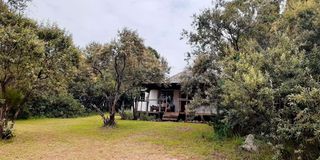Want to relax? Try Naivasha’s Malu Lodge

A view of Malu Lodge near Naivasha. Scattered across the 1,800 acres of the Malu reserve, the accommodation comprises two family villas, four cottages and one tree house.
My wife and I agreed that it would be good to have a relaxed break before a busy trip to the United Kingdom (UK), so we went for an overnight stay at Malu Lodge, a place recommended by friends.
Though the lodge is not far from Naivasha, set on the approach hills to the Kinangop, we had a hard time getting there.
First, there was thick fog after the turn-off to Limuru, which didn’t lighten up till the descent to Naivasha. Second, instead of trusting the map and directions sent to us by the lodge, we listened to the voice of the lady of Google Maps. She got us hopelessly lost. After telling us to do a U-turn, she gave up on us and went silent.
However, after following a young guy on a bike, who said he was going in the same direction, we made it for lunch, two hours after our estimated time.
Immediately, we were impressed by the lodge’s setting – in glades of one of our few remaining cedar forests, with views down the Rift Valley and up to the hills beyond. We were also impressed by the warm welcome of Samson, the lodge’s manager, and Raphael, who served us the delayed lunch.
The lunch was on the Clubhouse veranda. (Some time ago, the Italian founder had established the place as a members’ club.)
Dinner and the next day’s breakfast were inside, because of the season’s chill. The main clubroom is round, with a well-stocked bar. But its main feature is a central fireplace, where the hard cedar logs, gleaned from dead trees from the surrounding forest, flamed and crackled.
The present owner is Kim Mackenzie, son of Bruce Mackenzie, who was the Minister of Agriculture in President Kenyatta’s first Cabinet.
His lodge could in future be at the centre of an ambitious and conservation-inspired development plan, with plots of varying sizes, each of which would have only one house. This would help to protect the cedar forest, which is now threatened by illegal tree cutting.
As it is now, scattered across the 1,800 acres of the Malu reserve, the accommodation comprises two family villas, four cottages and one tree house. We were in one of the cottages. It had a king-size bed, hung with a mosquito net and beneath a white parachute-like canvas suspended from the makuti roof.
The bathroom was large, with both a bath and a shower. The electricity supply ensured lights, a kettle to boil, a fridge and phone charging. Two hot water bottles placed in the bed at night ensured warmth!
After settling into the cottage, Stephen, the lodge’s guide, took us on a walk through the forest. He was able to identify the birds by their calls – among them, a Narina Trogon and a Yellow-whiskered Greenbul. He knew the names and uses of all the trees, bushes and plants in the forest.
He told us the story of the Black Spider Wasp we saw: how it drags its paralyzed spider prey into an underground burrow, then lays eggs on it. The wasp larva hatches and eats the spider remains.
In the clubhouse we noticed a trunk full of children’s toys. Certainly, the Malu Lodge is an ideal place for a weekend family retreat from the cities. It’s a superb playground for children. They can cycle safely in the forest tracks. And they can enjoy the farm animals, especially the donkeys, cows and rabbits.
Samson told us that most of their visitors to the lodge are Kenyan citizens and resident expatriate families. I’m not surprised. Most foreign tourists come to Kenya to see the wildlife - especially the big five – or to relax at the Coast.
From Nairobi and to the lodge, the drive should take about two and a half hours – if you trust the directions you will receive and not listen to the voice of Google Maps!
For more information about the place, go to www.malu-kenya.com; for booking, ring 0701-665775.
- John Fox is Chairman of iDC Email: [email protected]





